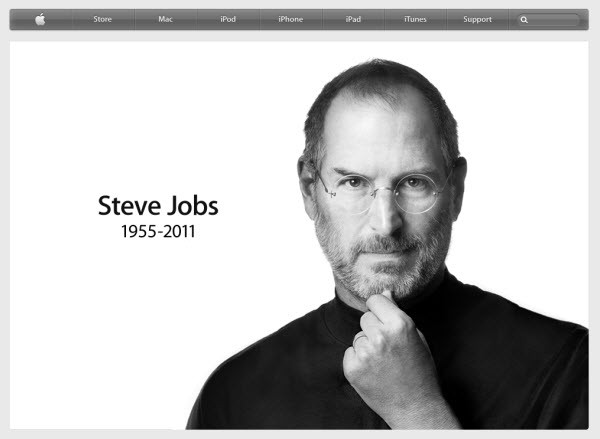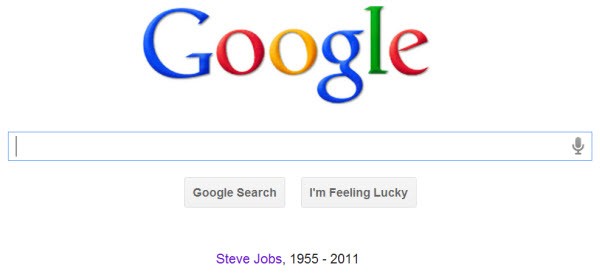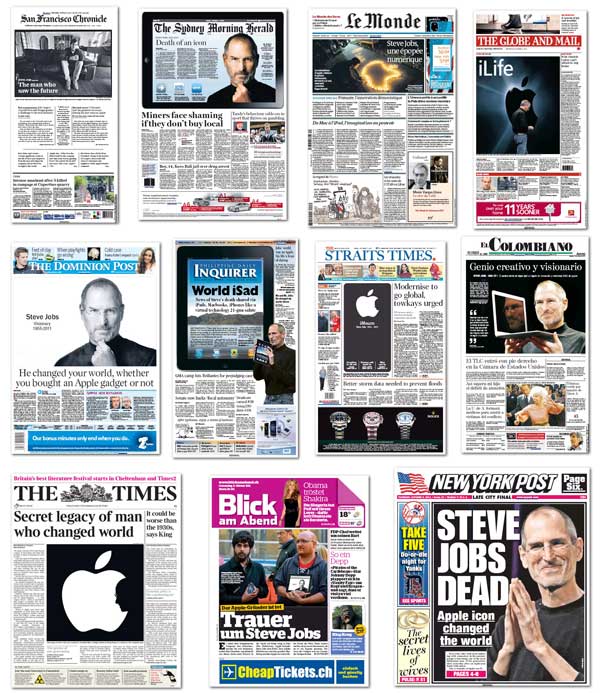He was the genius in the blue jeans and the black skivvy. Apple founder Steve Jobs passed away yesterday but his legacy — and incredible collection of inventions, from iPods and iPads to viable home computers and the technology behind Toy Story — lives on.
It seems appropriate that the outpouring of grief and sadness for Jobs occurred mostly on the internet, where users and media companies were quick to pay tribute to Jobs.
The Apple website still opens to this image:
Google, a large competitor of Apple in recent years, currently has a its own small Jobs tribute (and we expect an official Google Doodle to arrive soon) with a line underneath its search box, which links to the Apple site above.
The world’s newspapers, through their respective front pages, mourned the death of Jobs (click to see more):
Meanwhile eclectic culture and technology blog Boing Boing is paying tribute to Jobs in a clever way by recreating Macintosh’s iconic visuals:
This charming and cheesy photo gallery from The New York Times shows photos that readers have sent in illustrating the impact of Steve Jobs on their life. TechCrunch has a video of customers at the Apple store in San Francisco, who arrived to pay their respects, while Mashable has a photo gallery of all the tributes by Apple customers appearing at Apple stores around the globe.
“Well, the Apple empire has lost its emperor — but Jobs’s legacy is so toweringly impressive that it will be decades before we even begin to fully understand it,” writes Will Heaven in the UK’s Telegraph.’
The New York Times, famous for having a large obituary collection ready and waiting, had a five-page obituary on Jobs available just hours after his death. Written by John Markoff, it reads: “Mr Jobs was neither a hardware engineer nor a software programmer, nor did he think of himself as a manager. He considered himself a technology leader, choosing the best people possible, encouraging and prodding them, and making the final call on product design.”
Jobs made nerds cool, notes Patricia Sullivan in The Washington Post:
“He knew best of all how to market: ‘Mac or PC?’ became one of the defining questions of the late 20th century, and although Apple sold a mere 5 percent of all computers during that era, Mac users became rabid partisans.
Perhaps The Onion summed it up best: “Steve Jobs, the visionary co-founder of Apple Computers and the only American in the country who had any clue what the fuck he was doing…”
Not that Steve Jobs was the easiest guy to be around. Chris Taylor in Mashable paints a fascinating picture from a journalist’s point of view:
“Here’s how a typical press interview with Steve Jobs used to go in the early 2000s. You wouldn’t be immediately ushered into his presence; you would be passed from PR person to PR person, corridor to corridor, waiting at each step, until you reached the inner sanctum.
You would often pass a fellow journalist on his way out, looking white as a sheet and shaking his head like he’d gone 10 rounds with Mike Tyson. You would mentally prepare your questions about the latest Apple product, knowing that Steve would bat them away like flies and say what he wanted to say.
And then there you were, with the man himself: black turtleneck, jeans, white trainers, spiky salt-and-pepper stubble, and those no-nonsense eyes that could look straight into your soul. You’d sputter out a question while he sipped from a bottle of Odwalla. Perhaps he would deign to answer politely, or perhaps he would interrupt: “that’s a stupid question. That’s not what we should be talking about.”
If you could survive 20 minutes of this without cracking, his demeanor would soften. If you were lucky, then just for a moment the mask would slip, and Steve would break into a broad smile. It was a grin that acknowledged the silliness of this interview game — and that you both loved playing your roles in it.”
Lex Friedman in MacWorld really nails the reason why so many people seem to be more upset about the death of Steve Jobs than they’d expected to be:
“I can’t tell you the name of either one of RIM’s CEOs. Though I know his name, I honestly couldn’t pick Google CEO Larry Page out of a lineup, and I don’t know that I’ve ever heard his speaking voice, either. But I know just what Steve Jobs looked like, and just how he sounded. Not every CEO can — or should — show off his company’s products. But watching Steve deliver a keynote or host an Apple event, I wasn’t struck solely by his much-lauded showmanship. Part of what made a Jobs-helmed event so exciting to watch was his very real, very tangible passion for the products he was unveiling. Steve didn’t just run Apple — he loved it, and you could see that love, that pride, beaming from his face.
You hear people talk about television actors as the people we don’t know who we let into our homes, since they show up in our dens each night. Every Apple event, Steve showed up in my home too, wherever my Mac was. I would read the liveblog first, then watch the video as soon as Apple made it available. I’ve watched countless interviews with the man, too. So part of the reason I think his death hits me hard is because I really do feel like I knew him — even if he didn’t know me.”
And what now for Apple? Apple has been planning for the aftermath of Jobs’ death for years. Can it continue on without its founder? Perhaps the answer is to teach employees to be like Jobs. As Jessica Guynn writes in the LA Times:
“Deep inside its sprawling Cupertino, Calif, campus, one of the world’s most successful and secretive companies has had a team of experts hard at work on a closely guarded project.
But it isn’t a cool new gadget. It’s an executive training program called Apple University that Jobs considered vital to the company’s future: teaching Apple executives to think like him.”












Back in 2005–as it happens shortly after Jobs had made that graduation speech at Stanford and the transcript had quickly gone viral around the world–at my institute a senior staffer group-emailed a similar address by Bill Gates. It was filled with all the usual motherhood statements–work hard blah blah–and the contrast was just as you would expect. It was Mac versus PC and there was, as usual, no contest for anyone looking for real content or inspiration. So I did a rare thing and group-emailed to the entire 800 staff, the Jobs speech. (Crikey posted the video in yesterday’s CDM but the speech transcript is here: news-service.stanford.edu/news/2005/june15/jobs-061505.html). And I don’t know how many people I have sent it to over the years.
But here is the weird thing. Of the thousands or millions of tributes and comments made in the past 24 hours, undoubtedly the best one–and not listed here by Amber–is by none other than the anti-Steve Jobs himself, Bill Gates, when he said……”it was an insanely great honour”…to have shared the planet with Steve Jobs.
Yes he certainly challenged the almost monopoly Microsoft Windows and was fix to fix issues for consumers, unlike Microsoft, who let you drift
I am fascinated by this apparent deification of Jobs. I guess it’s a natural progression from fan-boy cult to actual cult. The same thing will no doubt happen when Bill Gates finally goes to the big blue screen in the sky. The sci-fi nerd in me is picturing a world hundreds of years in the future where the Jobbites and the Gatesians wage eternal ideological war. Depressing.
iCried
I think Ipods are the most over rated waste of money in history.